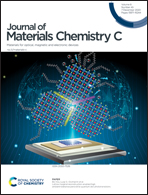Metal-free carbazole scaffold dyes as potential nonlinear optical phores: molecular engineering†
Abstract
In the light of diverse applications of nonlinear optical (NLO) chromophores in interdisciplinary fields, there is high demand for the quest of cost-effective and facile processing of smart materials. To narrow down such potential sensitizers, a profound physical understanding of the structure–property relationship is the need of the hour. The new molecular designs have triggered the development of simple carbazole scaffold dyes with D–π–A configurations, which can act as NLO chromophores. The theoretical and experimental frameworks of these novel molecular-engineered dyes exhibited strong charge-transfer absorption bands in the visible region besides high extinction coefficients and appropriate redox properties, making them promising canditates for NLO devices. Notably, the substitution of π-linkers and the insertion of the azo group on carbazole is critical for the optimal optoelectronic window, as evidenced by the spectral, electrochemical experiments, and density functional theory calculations. The state-of-the-art femtosecond (fs) Z-scan studies unveiled a strong third-order NLO susceptibility of ∼10−12 esu. Intriguingly, these dyes also exhibited reversible saturable absorption (RSA) kind of behavior when excited at 800 nm due to two-photon absorption (2PA), further augmenting them as alluring candidates for NLO device applications. The strong 2PA cross-sections [362–1890 GM] obtained for these molecules propitiously augur well for bio-imaging and other photonic applications.



 Please wait while we load your content...
Please wait while we load your content...